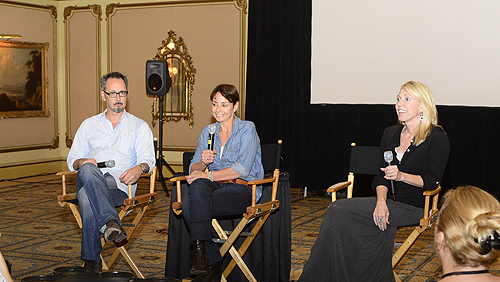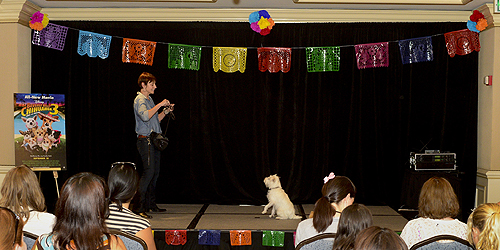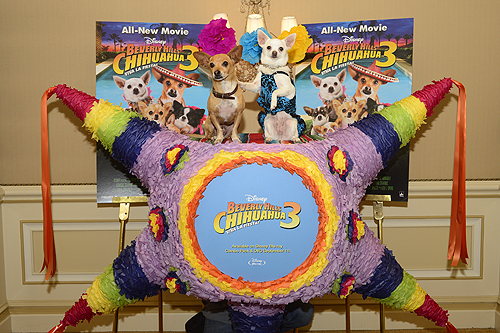 Ever wonder what it’s like to work with animals as the main stars of a Disney production? I sure did. Talking dogs? Dogs as the stars of the film…that isn’t animated?! Training dogs not only to talk, but to sing and play instruments?! How do they do it, the magic of Disney never fails to amaze! Here are a few things we learned from Beverly Hills Chihuahua 3 director Lev L. Spiro, producer Sara E. White, and animal trainer Mathilde de Cagny:
Ever wonder what it’s like to work with animals as the main stars of a Disney production? I sure did. Talking dogs? Dogs as the stars of the film…that isn’t animated?! Training dogs not only to talk, but to sing and play instruments?! How do they do it, the magic of Disney never fails to amaze! Here are a few things we learned from Beverly Hills Chihuahua 3 director Lev L. Spiro, producer Sara E. White, and animal trainer Mathilde de Cagny:
-the movie was filmed entirely at the Langham Pasadena and took over 5 weeks.
-the dogs live with their trainers and most of them used in the movie were rescues. at the end of the film it talks about pet adoption.
-on the busiest day, 27 dogs were on set. 3-8 dogs were used in scenes most days
-the dogs learn to “go to their mark” on command
-a pole with a tennis ball at the end (bait stick) was something they followed in order to get their heads to nod and move about
-filming days are 12 hours long but the dogs film intermittently throughout the day.
-dogs are trained for a period of 3 months: 2 months of basics and 1 month of movie-specific training.
-treats were used a lot to reward the dogs but Rusco (who plays Papi) once got a filet mignon, sometimes chicken, they have to mix it up
-a scene usually took 3-4 takes, 7-8 if it was a complicated scene.

Here’s even more. Q&A with Disney’s Beverly Hills Chihuahua 3 director Lev L. Spiro:
Q: AFTER READING THE SCRIPT, WHAT WAS YOUR PERSONAL VISION FOR THE FILM?
LS: What I wanted to do was keep the film very grounded. I wanted the audience watching talking dogs to be involved with characters that they cared about. Towards that end I wanted the dogs’ behavior to be rooted in reality. For example, the script called for the mariachi dogs to be playing instruments, and I thought to myself, how do you get dogs to play instruments without going off into a fantasy world? I just decided early on in my first pitch meeting that there are rules, if dogs are playing instruments, only other dogs can see them. Humans can never see dogs playing instruments.
There’s a whole world of unseen, unheard communication between dogs that we are not privy to as humans. And part of the fun of these films is you get to see dogs talking to each other with very sophisticated moods of expression. What humans hear is barking and dog noises. I decided that when humans are not watching, dogs can stand up and play instruments.
Q: YOU MUST HAVE FACED ENORMOUS CHALLENGES WORKING WITH ALL THOSE DOGS! PLEASE TELL US ABOUT THIS EXPERIENCE.
LS: That was interesting, because I came into this film thinking gosh, you know, I’ve done more than 100 episodes, pilots and features for television, I’ve worked with lots of animals before, this won’t be that much more difficult than what I’ve handled before. I had no idea! In the past I worked with one animal at a time. On our busiest day for this shoot we had 27 dogs on set! On any given day we would have three to eight dogs in scenes. It was very, very challenging and what made things even harder was that I didn’t want to block simplistic scenes where dogs walk onto marks and stand and face each other and we cut from static medium close shot to static medium close shot. I wanted to be able to block the scenes comedically and dramatically, with a moving camera, no differently than I would have blocked a scene with human actors.
So, there are a lot of scenes where a character walks into a scene and then another character walks by him and he turns and the blocking is fairly intricate. I’m actually very proud of that. I was told by the lead animal trainer, Mike Alexander, that director of photography Greg Gardner and I had pushed the envelope of canine blocking with this movie, which I set out to do. I do like to keep the camera moving, so that made it even more challenging because the dogs were not just walking in and hitting one mark and staying there for the rest of the scene.
Q: AMONG THE MANY FUN SCENES IN YOUR MOVIE ARE THE ONES WITH THE DOG MARIACHIS. WOULD YOU TALK A BIT ABOUT CREATING THESE SCENES.
LS: For the musical sequences I wanted the dogs to be moving and singing in time to the music, in order to give a layer of reality to it that wouldn’t have otherwise been there. I eventually asked both the trainers and the puppeteers if I could control the bait stick and the remote controls. For example, when the mariachis are singing in the audition sequence, you see each one’s head move as it sings its own vocal part, that’s because I had the bait stick and I got them to move on specific musical cues. But I had an incredible team of professionals and the dog trainers were really excited about the challenges that I was throwing at them.
Q: ALTHOUGH SPECIAL EFFECTS ARE USED IN YOUR FILM TO CREATE THE ILLUSION THAT THE DOGS ARE SPEAKING, HOW MUCH OF THEIR PERFORMANCE IS SIMULATED IN THIS WAY?
LS: Some of the dogs were naturally very expressive and I wanted to try to use that as much as I could. The dog that played Oscar has great eyebrows and when he shifted his head his eyebrows would kind of wag all over the place. So I didn’t mess with those at all. In other cases, we tried to suggest very subtle expressions by manipulating their eyebrows a little bit. But I’d say about 80 percent of what you see is natural dog expression and we’re only affecting their mouths.
I got one really great piece of advice from Raja Gosnell, who directed the first movie. I talked to him when I was in prep and one of the things he told me was that the visual effects people wanted the dogs to be as still as possible to make the effects easier in post, but that he wished he hadn’t done it that way because if a dog is supposed to be yelling, you miss some of the body language. He said “get the dogs to bark and it will look much better”. And I took that advice wholeheartedly and my visual effects supervisor, David Yrisarri, who was a tremendously creative contributor, encouraged me in that. So for example, when Pedro starts yelling to all the dogs at the hotel, “Come get your peanut butter,” he’s barking. The barking gave it, again a layer of reality because you want to see his rib cage moving, you see that he’s really taking in breaths to yell, “Come and get it, get your peanut butter!”
Q: IT’S DIFFICULT FOR US TO IMAGINE THE DEGREE OF DIFFICLTY THAT MUST HAVE GONE INTO THE TRAINING OF THE DOGS FOR THIS FILM. BUT YOU HAD MIKE ALEXANDER, ONE OF THE MOST PROMINENT ANIMAL TRAINERS IN THE BUSINESS, ON BOARD.
LS: None of this film would have been possible without Mike. Mike was amazing, he was on the set all the time, every day, supervising what was going on, coaxing the trainers to get more out of the animals, helping me do the ridiculously complicated blocking. I would go up to him and say, I know we didn’t rehearse this, but could we do such and such. He’d take a deep breath and look at me and I’d see his hair turning gray before my eyes. And then he would go figure out how to do it. So he was amazing
Q: NOW THAT YOU’VE DIRECTED “BEVERLY HILLS CHIHUAHUA 3: VIVA LA FIESTA!” YOU WILL BE FOREVER LINKED TO THE HONORABLE DISNEY LEGACY FOR QUALITY FAMILY ENTERTAINMENT. HOW DOES THAT MAKE YOU FEEL?
LS: Extremely proud. It’s funny, I went to a high school reunion a few years ago, and “Wizards of Waverly Place: The Movie,” had come out. And I was a huge celebrity at this reunion because all these people my age had kids that loved the movie. I had never seen myself going into family entertainment. The comedy I enjoy most tends to be a little bit more grown up. But, you know, it felt really good that I had made an impact on all these kids’ lives. That they had seen this movie that they had resonated with emotionally. That felt good. Disney has such an amazing history of making great, great movies for families. So I’m very proud to be part of that. I also tried to put as much adult comedy in this as I could, because I know when kids like something, they make their parents watch it over and over and over again. I know this from the two Disney Channel films I’ve done. I’ve had parents thank me for making funny and watchable movies because they have to watch them over and over and over again.
And for the moment that you all have been waiting for….my interview with Papi and Chloe!
Jen: Who was the biggest Diva on set?
Papi: Paws down, Sebastian.
Chloe: It’s true; even I’m no match for a pug who’s declared war on wrinkles. If Sebastian got any less than 18 hours of sleep, he refused to leave his trailer till the fur and makeup crew had him looking fresher than a newborn pup.
Jen: Do you think Human actors or Animal Actors are easier to cast?
Papi: Animal actors!
Chloe: I’m with Papi. The humans need too much training.
Jen: What did you think about the LanghamHuntington?
Papi: It was nice and all, but if you ask me, the food was a little bland. If the restaurant can afford five Michelin stars, you’d think they could afford one jalapeño! It’s a good thing they hired Rachel.
Chloe: I’ll sum it up in two words: Shi-itzu. Massage.
Jen: What did you enjoy doing when you were not on set?
Papi: I’m not a helicopter dad or anything, but there’s nothing wrong with being a few steps ahead when it comes to my pups’ education. So when I wasn’t on set, I threw together a few extra lesson plans. Just enough to cover them for the next 10 or 15 years.
Chloe: See my last answer
Jen: Which of your “babies” were the easiest to work with?
Papi: Rosita had the most to learn, and she did it all with her tail wagging!
Chloe: They’re all so talented, it’s impossible to choose just one! I mean, obviously not Papi Jr. Not that I love him any less, but Sam and Rachel are still working off the hotel room damages
There you have it, the magic of Disney!
I’m honored to have participated in this amazing event. All thanks to Disney, the Langham Huntington Pasadena, and the Beverly Hills Chihuahua cast and crew! Photos not watermarked provided by Disney.



